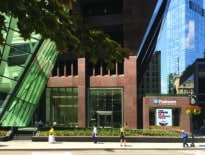
Adam Subber (left) and Dan Sullivan (right)
Take the pulse of the commercial real estate market right now and you’ll see a fundamental imbalance in the supply and demand for office space in the city of Boston.
For occupiers in need of 25,000 square feet or more, the option pool for space is dwindling. Supply, by way of new construction, is coming, but not available in meaningful amounts until 2021. Today, the scarcity of quality office space is real, and its impact has a ripple effect on many aspects of the market and business climate.
Companies focused on growth and competing for top talent, especially technology and biopharma firms, are pursuing core urban locations primarily to attract and retain employees in Boston’s tight labor market. Across the board, companies are seeking office and building amenities that inspire their workforce and foster company culture. Real estate’s transformation from “cost center” to requisite workplace benefit is in full bloom.
While available office space in Boston is dwindling, it has become nearly extinct in the smaller market of nearby Cambridge. Vacancy is less than 1 percent in all of Cambridge and essentially zero in Kendall Square, the hub of Cambridge’s biotech sector. The market is being driven by global powerhouse companies and well capitalized startups, both of which are undaunted by increasing rents and often snatch up large office and lab spaces with longer leases – sometimes before available space even publicly hits the market. Young companies are tapping coworking space as available spaces smaller than 10,000 square feet are harder and harder to locate and secure.
Longer Lease Terms Becoming More Common
The lack of available office space in Boston is forcing some occupiers to “reverse migrate” or seriously consider alternatives in less coveted locations. If occupiers are not willing to pay significantly higher rents on their next office lease, inner suburban and Route 128 locations start to look more attractive. With space in new and anticipated construction projects already spoken for, it will be a while until supply catches up to demand.
Perhaps ironically at a time when the explosion of coworking options has provided occupants significant term flexibility, we continue to see no hesitation from significant corporate users to making long-term investments. Where seven to 10 years used to be considered long-term, 12- to 15-year leases are no longer unheard of in this market. In addition, companies are increasingly relying on the use of shadow (or off-market) space to bridge the gap between the need for bigger facilities and the lack of real estate choices.
Continued demand has also driven the “multi-party” phenomena, wherein an ever-increasing number of leases involve multiple tenants, with attendant buyouts and bartering or space swaps, in order to achieve desired long-term outcomes for large, strong credit occupiers. Land banking of space has become more typical as well, as well-educated tenants recognize that they will be in control of a valuable asset with which they can manage their own needs in the coming years vis-à-vis short-term subleases.
It sounds trite, but if you snooze, you lose in today’s competitive commercial real estate market. Barring a macroeconomic event that causes global economic slowdown, we see little reason to believe that 2019 will hold anything other than more of the same competitive circumstances for tenants. That said, there are always ways to build competition for tenancies. Being educated and poised for action is the best preparation for urban tenants in Greater Boston these days.
Adam Subber and Dan Sullivan are managing principals in the Boston office of Cresa, the world’s largest occupier-focused commercial real estate firm.




 |
| 
